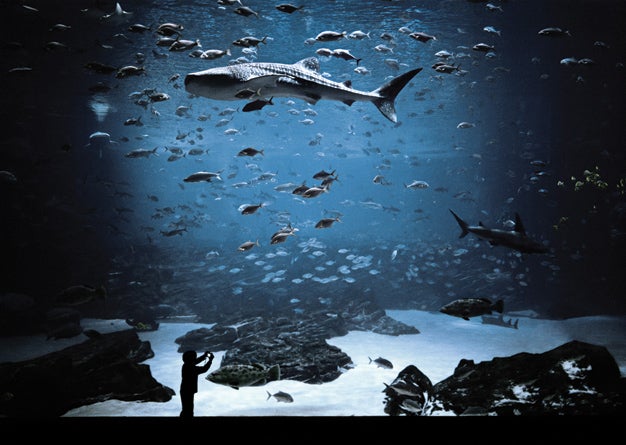Tips for taking stunning aquarium pictures
You don't need underwater housing gear to capture the creatures of the sea.

Shooting in a massive public aquarium may be your only opportunity to net a sea creature as magnificent as Kyle Ford’s whale shark, above. The project will be fun, if fraught with challenges.
The good news? Ford, a fine-art shooter and photography professor at Skidmore College in Saratoga Springs, NY, has catalogued a set of techniques that makes shooting in large aquariums doable. Here we offer a handful of his best.
- Arrive early—as soon as the aquarium opens—to avoid crowds. And if you have the choice, stick with aquariums that permit the use of tripods.
- Avoid distortion by placing your camera parallel to the glass wall of the tank.
- Turn off on-camera flash to prevent distracting reflections.
- Focus on nearby creatures.The more water between your camera and your subject, the softer the focus will be.
- Include human silhouettes. They’ll inject an important sense of scale and dimension.
- Concentrate on light, silvery fish rather than darker species, which can blend into backgrounds.
- Use a high-speed lens so you can set fast, action-stopping shutter speeds. Slow-swimming fish are easier to capture sharply than darters.
- Consider combining images with software, as Ford did for the image shown here. Because it’s hard to catch multiple species attractively in a single shot, he made separate photos of the fish in this tank. He combined them in Adobe Photoshop later using layers and masks.
Step 1
Scout the aquarium. The day before you shoot, visit the aquarium and decide which scenes to capture. Determine where to set your tripod and what equipment to bring. Gauge visitor traffic and determine the best shooting times.
Step 2
Set up your rig. On the day of your shoot, set up your DSLR and tripod. Focus, then check it by zooming into a test image on the LCD. When the scene is adequately sharp, lock focus by switching to Manual Focus. Make sure the MF ring doesn’t shift as you shoot.
Step 3
Meter and set exposure. Ford recommends spot-metering the darkest subject area for which you want detail and then closing down two stops. Shoot in RAW at the lowest ISO that will allow a shutter speed no slower than 1/60 sec. If you intend to combine images, use identical exposures for each.
Step 4
Get their best sides. Shoot when the fish are close to the glass and their body language is colorful and indicative of the species. “It’s a bit like hunting,” says Ford. “I wait for a series of decisive moments. It took three hours to make the 10 images that I combined for this shot.”
Final Step
Fine-tune in post. Adjust sharpness, contrast, and color balance, and clean up debris and bubbles. Making a realistic-looking composite image takes a lot of practice and patience to build your skills. “It’s a meticulous process that actually feels a lot like painting,” says Ford.